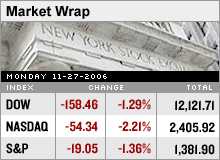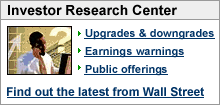Wall St.'s worst day in monthsNasdaq slumps over 2%, Dow pares about 158 points as weak dollar, higher oil prices, Wal-Mart rattle investors.NEW YORK (CNNMoney.com) -- Stocks slumped Monday, with the Dow industrials posting its biggest one-day percentage drop since July, as investors eyed higher oil prices, a weaker dollar and a cautious outlook from Wal-Mart and decided to head for the exits. Jitters about the slew of economic news due later this week weighed as well, as did a sense that the recent rally was due for a pullback.
The Dow Jones industrial average (down 158.46 to 12,121.71, Charts) lost around 158 points, or 1.3 percent, seeing its biggest one-day point and percentage drop since July 13. The broader S&P 500 (down 19.05 to 1,381.90, Charts) index slid 1.4 percent, seeing its biggest one-day percentage loss since June 5. Last week, the S&P 500 hit a six-year high. The Nasdaq composite (down 54.34 to 2,405.92, Charts) lost 2.2 percent, seeing its biggest one-day percentage decline since June 5. The tech-fueled index touched a nearly six-year high last week. The Russell 2000 (up $0.00 to $20.29, Charts), the small-cap stock benchmark, lost nearly 2.6 percent. Treasury prices inched higher, lowering the corresponding yields. The dollar slumped versus the euro. Oil and gold prices jumped. As of 5:45 p.m. ET, Nasdaq and S&P futures pointed to a mixed open Tuesday, when fair value is taken into account, suggesting the big selloff could prove to be a one-day event. No market-moving earnings are due Tuesday morning. Instead, investors will be focused on the October durable goods orders report, the November consumer confidence report and the October existing home sales report. Having rallied since the summer, stocks were probably vulnerable for a bit of a pullback Monday, analysts said. That was exacerbated by some negative news Monday, including a slide in the U.S. dollar to a 20-month low versus the euro, a nearly 2 percent jump in the price of oil, and a big run up in gold prices. In corporate news, a weak outlook from Wal-Mart Stores called into question the otherwise robust early reports on the start of the holiday shopping period. "I think you've had a very significant move over the last couple of months, with the market wanting to go up, so if people want to take some profits now, it isn't hard to find reasons why," said Douglas Altabef, managing director at Matrix Asset Advisors. He said that more than anything else, the selloff was related to bulls taking a hiatus of sorts after the advance. As of Friday's close, the Nasdaq was up 11.6 percent year-to-date and up 8.6 percent in the fourth quarter. The Dow was up 14.6 percent in 2006 and 5.1 percent since Sept. 30. The S&P 500 had risen 12.2 percent this year and 4.9 percent since the end of September. Small caps have risen even more, with the Russell 2000 up 17.7 percent in 2006, as of Friday, and up 9.2 percent in the third quarter. Since bottoming in July, stocks have been on a tear, with investors reacting to a variety of supportive factors. They include: lower oil prices, strong corporate earnings, a Federal Reserve that seems to be on hold, and an economy that appears to be slowing enough to cool inflationary pressures, but not so much as to be heading toward a recession. However, concerns about the economy remain, particularly amid the slowdown in the housing market, and market participants may have been jittery about the bevy of reports due later this week. Reports are due on new and existing home sales, personal income and spending, gross domestic product growth, manufacturing and construction . Ahead of those reports, a pair of brokerages issued forecasts on stocks and the economy in 2007. A Citigroup (Charts) economist and market strategist both said Monday that worries about the housing market slowdown are overdone and should not send the economy into a recession or cause the markets to slump next year. A Goldman Sachs report forecast the S&P 500 should reach 1,460 by next September, a modest 4.2 percent increase over Friday's close, Briefing.com reported. All financial markets were closed Thursday for Thanksgiving and attendance was light for Friday's shortened session. Attendance was not back at full speed Monday, with some Wall Street professionals still returning after the holiday, said Tom Schrader, co-head of listed trading at Legg Mason. "Tomorrow will be a better indicator," he said, of whether the stock selloff has legs. What moved? Stock declines were widespread, with most sectors under water, led by financials, airlines and technology. Goldman Sachs (down $8.49 to $193.11, Charts), E*Trade Financial (down $1.23 to $24.10, Charts) and Bear Stearns (down $7.60 to $151.00, Charts) all lost more than 4 percent, dragging down the Amex Securities Broker/Dealer (Charts) index by 3.6 percent. Airline stocks slid in response to the rise in oil prices. Continental (down $3.31 to $42.07, Charts) lost over 7 percent and American Airlines parent AMR (down $1.90 to $32.20, Charts) lost 5.6 percent. The Amex Airline (Charts) index fell 4.6 percent. Google (down $20.25 to $484.75, Charts) slipped 4 percent after a report in Barron's over the weekend said the stock - which recently surpassed $500 per share for the first time - may be too expensive relative to earnings. A variety of big tech stocks slid, including Dow components IBM (down $1.90 to $91.45, Charts), Intel (down $0.57 to $21.02, Charts) and Hewlett-Packard (down $0.92 to $38.64, Charts), which all lost at least 2 percent. In total, 27 out of 30 Dow components slid. Other big decliners included Boeing (down $2.40 to $87.37, Charts), down 2.7 percent and United Technologies (down $1.15 to $64.84, Charts), down 1.7 percent. One bright spot: initial positive reports from retailers on "Black Friday," the day after Thanksgiving and the start of the holiday shopping period. Reports continued to flow in over the weekend, suggesting shoppers came out in droves, although it was unclear how this would impact retailers' overall profits. (Full story). Yet, those reports were somewhat overshadowed by Wal-Mart Stores, which forecast over the weekend that November sales at stores open a year or more, also known as same-store sales, would fall 0.1 percent. The forecast included the "Black Friday" results. Wal-Mart (down $1.29 to $46.61, Charts), a Dow component, fell 2.7 percent Monday. Market breadth was negative. On the New York Stock Exchange, losers topped winners by more than four to one on volume of nearly 1.6 billion shares. On the Nasdaq, decliners beat advancers by a similar margin on volume of 1.97 billion shares. Rising oil prices also added a sense of caution to the markets. U.S. light crude oil for January delivery rose $1.08 to settle at $60.32 a barrel on the New York Stock Exchange. Treasury bond prices inched higher, lowering the yield on the 10-year note to 4.53 percent from 4.55 percent late Friday. Treasury prices and yields move in opposite directions. In currency trading, the dollar slumped to a 20-month low versus the euro and rose modestly versus the yen. COMEX gold rose $11.70 to settle at $647.10 an ounce. Rally rolls on. But watch out come January |
|






